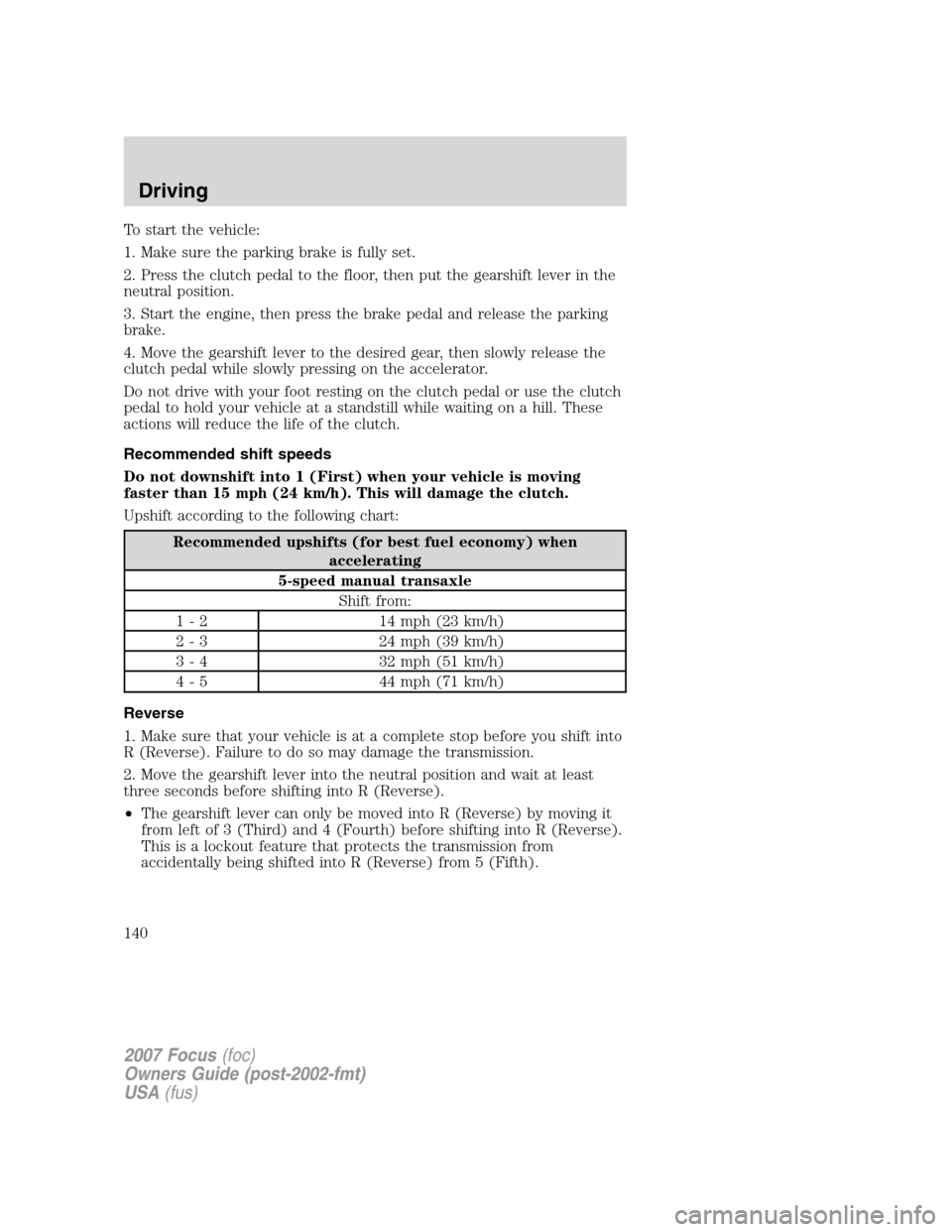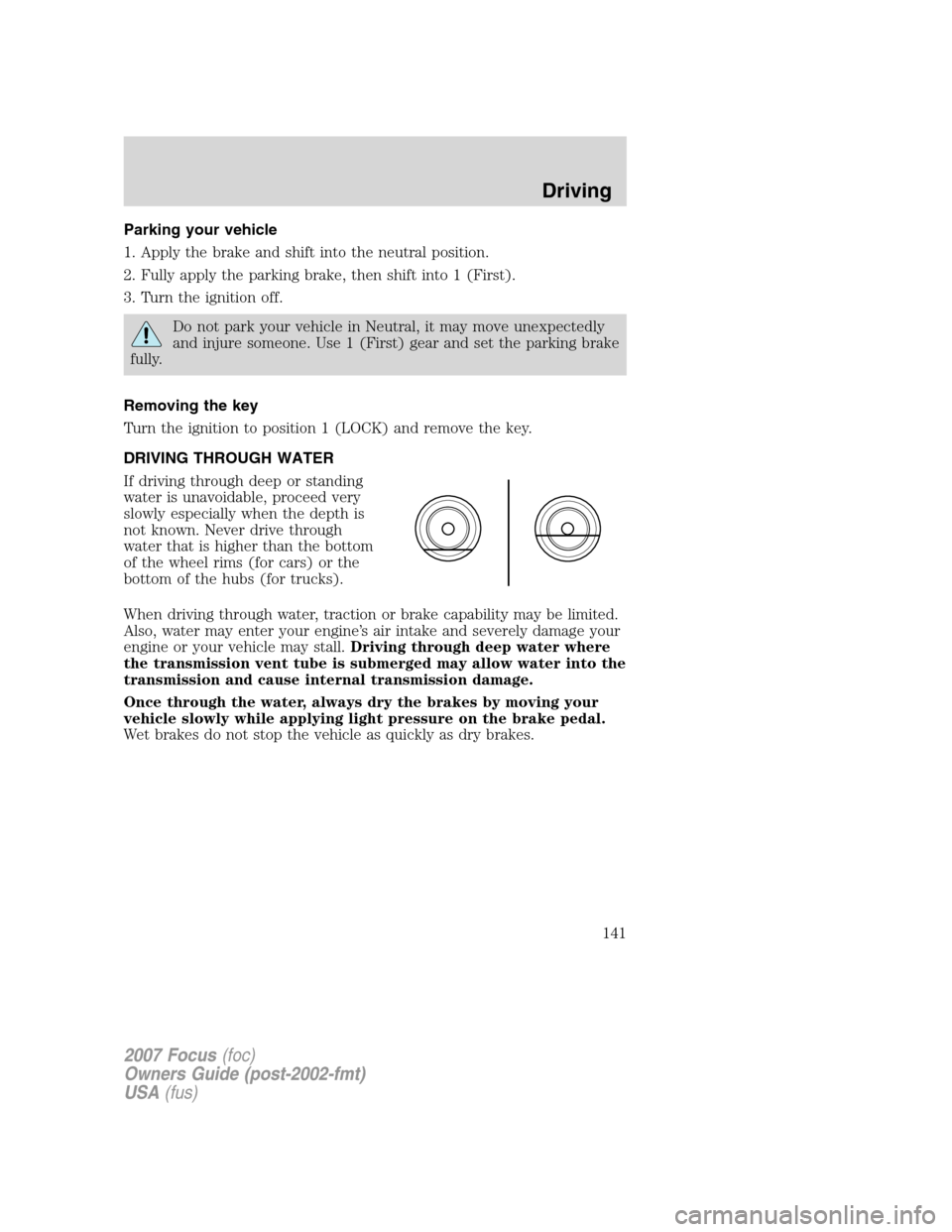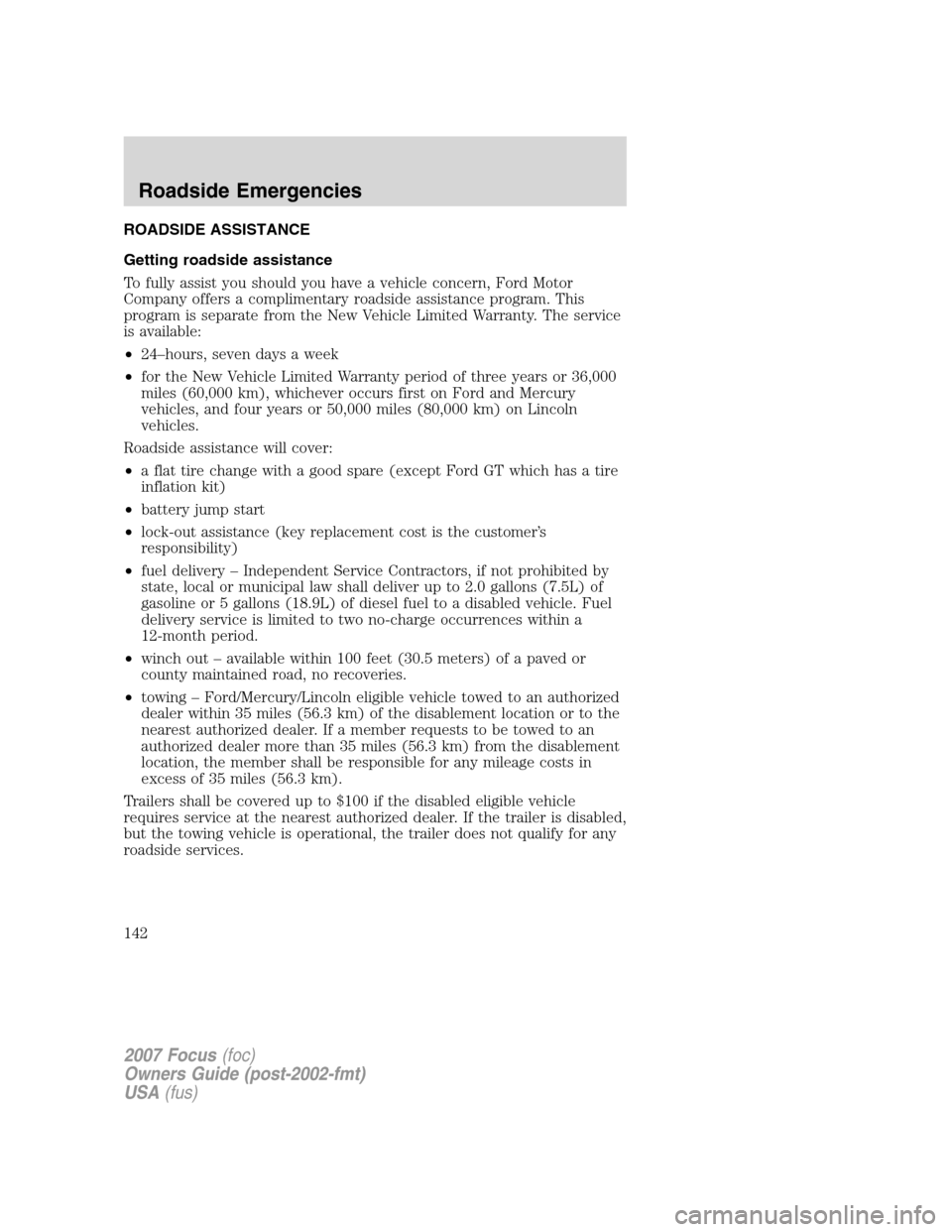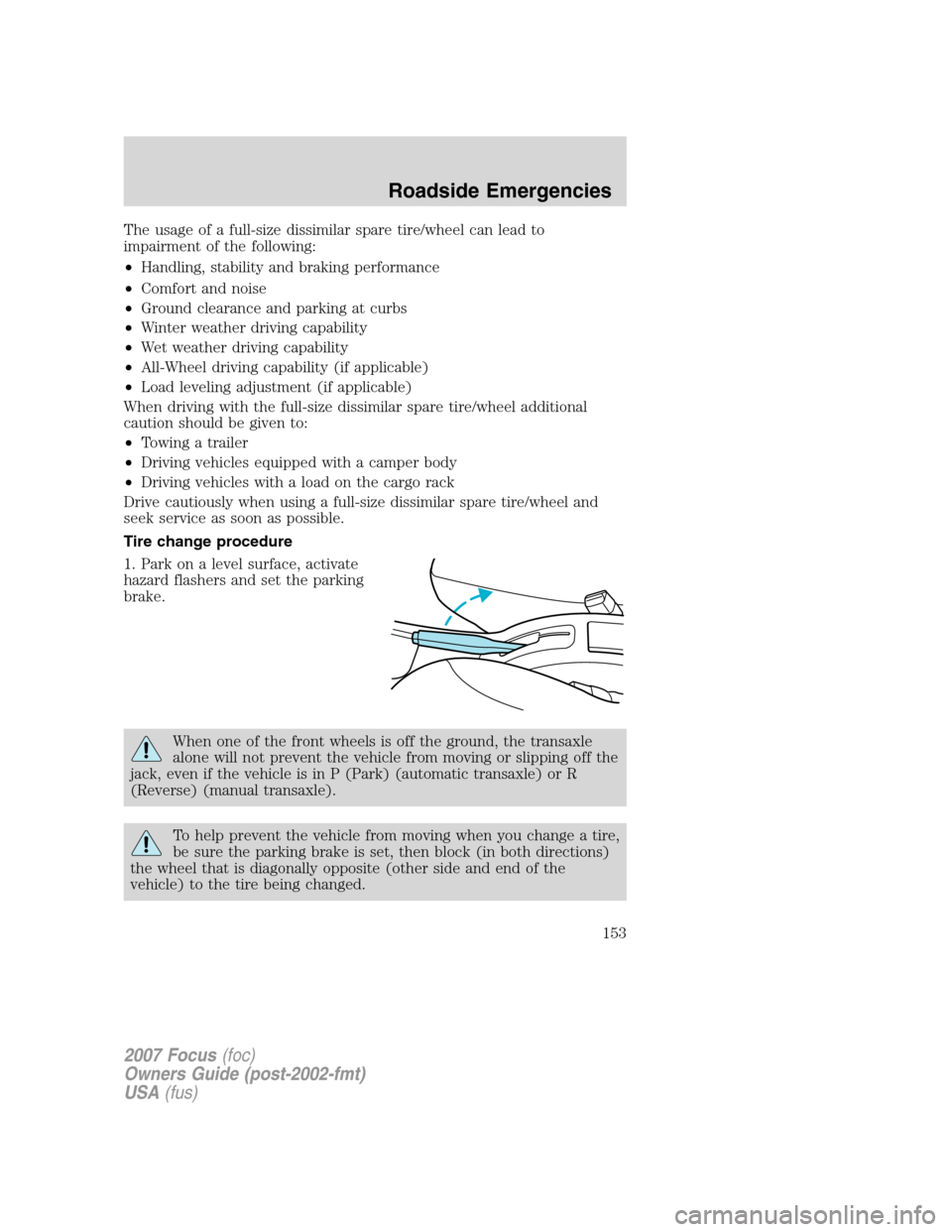Page 140 of 224

To start the vehicle:
1. Make sure the parking brake is fully set.
2. Press the clutch pedal to the floor, then put the gearshift lever in the
neutral position.
3. Start the engine, then press the brake pedal and release the parking
brake.
4. Move the gearshift lever to the desired gear, then slowly release the
clutch pedal while slowly pressing on the accelerator.
Do not drive with your foot resting on the clutch pedal or use the clutch
pedal to hold your vehicle at a standstill while waiting on a hill. These
actions will reduce the life of the clutch.
Recommended shift speeds
Do not downshift into 1 (First) when your vehicle is moving
faster than 15 mph (24 km/h). This will damage the clutch.
Upshift according to the following chart:
Recommended upshifts (for best fuel economy) when
accelerating
5-speed manual transaxle
Shift from:
1 - 2 14 mph (23 km/h)
2 - 3 24 mph (39 km/h)
3 - 4 32 mph (51 km/h)
4 - 5 44 mph (71 km/h)
Reverse
1. Make sure that your vehicle is at a complete stop before you shift into
R (Reverse). Failure to do so may damage the transmission.
2. Move the gearshift lever into the neutral position and wait at least
three seconds before shifting into R (Reverse).
•The gearshift lever can only be moved into R (Reverse) by moving it
from left of 3 (Third) and 4 (Fourth) before shifting into R (Reverse).
This is a lockout feature that protects the transmission from
accidentally being shifted into R (Reverse) from 5 (Fifth).
2007 Focus(foc)
Owners Guide (post-2002-fmt)
USA(fus)
Driving
140
Page 141 of 224

Parking your vehicle
1. Apply the brake and shift into the neutral position.
2. Fully apply the parking brake, then shift into 1 (First).
3. Turn the ignition off.
Do not park your vehicle in Neutral, it may move unexpectedly
and injure someone. Use 1 (First) gear and set the parking brake
fully.
Removing the key
Turn the ignition to position 1 (LOCK) and remove the key.
DRIVING THROUGH WATER
If driving through deep or standing
water is unavoidable, proceed very
slowly especially when the depth is
not known. Never drive through
water that is higher than the bottom
of the wheel rims (for cars) or the
bottom of the hubs (for trucks).
When driving through water, traction or brake capability may be limited.
Also, water may enter your engine’s air intake and severely damage your
engine or your vehicle may stall.Driving through deep water where
the transmission vent tube is submerged may allow water into the
transmission and cause internal transmission damage.
Once through the water, always dry the brakes by moving your
vehicle slowly while applying light pressure on the brake pedal.
Wet brakes do not stop the vehicle as quickly as dry brakes.
2007 Focus(foc)
Owners Guide (post-2002-fmt)
USA(fus)
Driving
141
Page 142 of 224

ROADSIDE ASSISTANCE
Getting roadside assistance
To fully assist you should you have a vehicle concern, Ford Motor
Company offers a complimentary roadside assistance program. This
program is separate from the New Vehicle Limited Warranty. The service
is available:
•24–hours, seven days a week
•for the New Vehicle Limited Warranty period of three years or 36,000
miles (60,000 km), whichever occurs first on Ford and Mercury
vehicles, and four years or 50,000 miles (80,000 km) on Lincoln
vehicles.
Roadside assistance will cover:
•a flat tire change with a good spare (except Ford GT which has a tire
inflation kit)
•battery jump start
•lock-out assistance (key replacement cost is the customer’s
responsibility)
•fuel delivery – Independent Service Contractors, if not prohibited by
state, local or municipal law shall deliver up to 2.0 gallons (7.5L) of
gasoline or 5 gallons (18.9L) of diesel fuel to a disabled vehicle. Fuel
delivery service is limited to two no-charge occurrences within a
12-month period.
•winch out – available within 100 feet (30.5 meters) of a paved or
county maintained road, no recoveries.
•towing – Ford/Mercury/Lincoln eligible vehicle towed to an authorized
dealer within 35 miles (56.3 km) of the disablement location or to the
nearest authorized dealer. If a member requests to be towed to an
authorized dealer more than 35 miles (56.3 km) from the disablement
location, the member shall be responsible for any mileage costs in
excess of 35 miles (56.3 km).
Trailers shall be covered up to $100 if the disabled eligible vehicle
requires service at the nearest authorized dealer. If the trailer is disabled,
but the towing vehicle is operational, the trailer does not qualify for any
roadside services.
2007 Focus(foc)
Owners Guide (post-2002-fmt)
USA(fus)
Roadside Emergencies
142
Page 147 of 224
Fuse/Relay
LocationFuse Amp
RatingPassenger Compartment Fuse
Panel Description
R24 — Not used
R25 — Rear defrost/Heated mirror relay
30 10A Parking lamps
31 20A Radio
32 15A Turn signal (GEM)
33 20A Sunroof
34 20A Horn
35 7.5A A/C switch, Instrument cluster
36 7.5A Interior lamps, Power mirrors
37 — Not used
38 — Not used
39 2A PCM relay coil
40 25A Rear defroster
41 — Not used
42 10A Stop lamps, Shift interlock
43 15A Rear wiper, Sunroof (ignition)
44 15A Daytime Running Lamps (DRL)
45 7.5A Recirculated air, Air conditioning
46 — Not used
47 20A Cigar lighter/Power point
48 10A Data link connector
49 7.5A Heated mirror, Heated backlite
indicator
50 10A Back- up lamps (automatic
transaxle only)
51 7.5A Front passenger sensing system
52 15A Heated seats
53 10A Back-up lamps (manual transaxle
only), Speed control
54 25A Rear power windows
55 25A Front power windows
2007 Focus(foc)
Owners Guide (post-2002-fmt)
USA(fus)
Roadside Emergencies
147
Page 148 of 224

Fuse/Relay
LocationFuse Amp
RatingPassenger Compartment Fuse
Panel Description
56 20A Front wipers
57 7.5A Radio and cluster (accessory)
58 — Not used
59 7.5A Light switch (headlamps)
60 7.5A Air bag module
61 7.5A PATS modules, Instrument cluster
62 7.5A Radio (Start)
63 20A Power locks (GEM)
Fuse 63 is located on the back of the fuse panel. See your authorized
dealer for service of this fuse.
Power distribution box
The power distribution box is located in the engine compartment. The
power distribution box contains high-current fuses that protect your
vehicle’s main electrical systems from overloads.
Always disconnect the battery before servicing high current
fuses.
To reduce risk of electrical shock, always replace the cover to
the Power Distribution Box before reconnecting the battery or
refilling fluid reservoirs.
If the battery has been disconnected and reconnected, refer to the
Batterysection of theMaintenance and Specificationschapter.
2007 Focus(foc)
Owners Guide (post-2002-fmt)
USA(fus)
Roadside Emergencies
148
Page 149 of 224
To remove a fuse, use the fuse puller tool provided on the power
distribution box cover.
The high-current fuses are coded as follows:
Fuse/Relay
LocationFuse Amp
RatingPower Distribution Box
Description
1 40A Main power supply (to passenger
compartment fuse panel)
2 — Not used
3 — Not used
4 30A Air pump motor (PZEV engine
only)
5 30A Anti-lock Brake System (ABS)
(pumps)
6 50A Engine cooling fan (Primary fuse)
7 40A Main power supply (to passenger
compartment fuse panel)
8 30A Ignition switch, Starter solenoid
9 20A Engine management
2007 Focus(foc)
Owners Guide (post-2002-fmt)
USA(fus)
Roadside Emergencies
149
Page 150 of 224
Fuse/Relay
LocationFuse Amp
RatingPower Distribution Box
Description
10 1A Battery voltage sense
11 30A Subwoofer
12 15A Fuel pump motor
13 20A Anti-lock Brake System (ABS)
(valves)
14 — Not used
15 — Not used
16 10A Low beam (left-hand side)
17 10A Low beam (right-hand side)
18 15A Heated Exhaust Gas Oxygen
(HEGO) sensors
19 40A Heater blower motor
20 10A Engine module (KAP)
21 10A A/C
22 20A Low beams
23 15A High beams, Fog lamps
24 — Not used
25 — Not used
26 — Not used
27 — Not used
28 — Not used
29 10A ABS module, Speed control
R1 — Ignition relay
R2 — High beam relay, Fog lamps relay
R3 — Cooling fan (high-speed)
R4 — Cooling fan (low-speed)
R5 — A/C relay
R6 — Low beams relay
R7 — Fuel pump relay
R8 — Engine management relay
R9 — Cooling fan relay
2007 Focus(foc)
Owners Guide (post-2002-fmt)
USA(fus)
Roadside Emergencies
150
Page 153 of 224

The usage of a full-size dissimilar spare tire/wheel can lead to
impairment of the following:
•Handling, stability and braking performance
•Comfort and noise
•Ground clearance and parking at curbs
•Winter weather driving capability
•Wet weather driving capability
•All-Wheel driving capability (if applicable)
•Load leveling adjustment (if applicable)
When driving with the full-size dissimilar spare tire/wheel additional
caution should be given to:
•Towing a trailer
•Driving vehicles equipped with a camper body
•Driving vehicles with a load on the cargo rack
Drive cautiously when using a full-size dissimilar spare tire/wheel and
seek service as soon as possible.
Tire change procedure
1. Park on a level surface, activate
hazard flashers and set the parking
brake.
When one of the front wheels is off the ground, the transaxle
alone will not prevent the vehicle from moving or slipping off the
jack, even if the vehicle is in P (Park) (automatic transaxle) or R
(Reverse) (manual transaxle).
To help prevent the vehicle from moving when you change a tire,
be sure the parking brake is set, then block (in both directions)
the wheel that is diagonally opposite (other side and end of the
vehicle) to the tire being changed.
2007 Focus(foc)
Owners Guide (post-2002-fmt)
USA(fus)
Roadside Emergencies
153